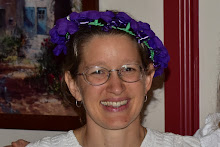Wednesday: Math. Because my inlaws are out of town, I didn't go to Arabic Bible study, but did school with the kids in the morning. P and E started learning a new hymn ("Up From the Grave He Arose"), so we reviewed that and "Holy, Holy, Holy", our memory verse for the week (1 John 1:9, which both kids struggled with), and catechism question; we updated the calendar, P read her reader and did her math 5-a-day review sheet, and E traced the plastic-plate shapes from his "school" last week. I then introduced subtraction with multiple-digit numbers without regrouping. I think the only real challenge for P will be noticing whether there's a plus or a minus sign on the problem - she grasped the concept easily, but when I wrote the first problem on the board, she treated it like an addition problem. I then wrote 2 almost identical problems - the only difference being the sign (62+31 vs. 62-31) - and asked P the difference between the two. She saw the difference quickly. I hauled out the dimes and pennies - 6 dimes and 2 pennies, and asked her to remove 3 dimes and a penny. We worked another problem with coin manipulatives, and then one without, and she did great. I've put a multiple-digit subtraction problem on her Friday 5-a-day, so we'll see how she does with that. We looked again at the "Primary Grade Challenge Math" problem in which a girl is given 2 options for increasing her allowance - either an extra $4/week per year, or doubling the amount per week each year, starting with $2. I graphed it on graph paper, explaining each step, and the kids both watched attentively. I don't really expect them to grasp it in full at this stage, but it introduces the concept of graphing. I then took out the Think-It-Through tiles for P and the pegboard with rubber bands for E, and they played with those for a while. When we put away the pegboard, I set up "axes" of pegs. There are 25 (actually 24, since we lost one) in 5 colours and 5 shapes in each colour. So I set up a row of red shapes, with a circle at the end, and put the circles of all the other colours in the same column. I then showed them how to place each remaining peg by finding the correct row for the colour and column for the shape. By the end of putting them away, they were doing it by themselves.
In the afternoon, we went to a homeschool group that I just found, which I really enjoyed. It was their annual "project day", when kids brought in various projects they'd been working on. These ranged from memorized poems, to origami, to a fractal triangle poster made by a girl who didn't look much older than P, to a pair of boys, ages 10 and 15, who had participated in a LEGO robotics competition and brought their robots to demonstrate. This was really amazing and reminded me a lot of the ME72 competition at Caltech. If any of my kids is interested in robotics in a few years' time, this looks like such an amazing thing to do. The people in the group were friendly and easy to talk to, and P and E got along with the other kids once they warmed up, so I think we may end up sacrificing one Wednesday a month to be able to go to their monthly meetings.
Thursday: Bible and Music. Today in CBS the kids made "kazoos" decorated with green handprints to look like palm branches, and learned about Jesus' triumphal entry into Jerusalem. We read the story of Palm Sunday in 101 Favorite Stories from the Bible, and went on to read about the Lord's Supper as well. I didn't introduce a new verse, because they were still struggling with the last one, but I did introduce the next catechism question. When I told P it was time for her piano lesson, she asked if we could do it upstairs in her room. "Sure, P. Why don't you just carry the piano upstairs?" Silly question, silly answer. However, she grasped the relationship between quarter notes and half notes instantly (it takes 2 quarters to make a half), which was fun. I like how this program teaches the kids to count out quarter ("play and") and half ("play and hold it") notes - it makes way, WAY more sense than the Bastien method which has kids say "quarter" in just one beat and "half note" in two beats (seriously - who takes twice as long to say "half note" as "quarter"?). The whole note will be "play and hold it even longer", and I imagine that the eighth note will just be "play" - this is a sensible way to attach words to the rhythms. P had fun drawing a quarter note over each of the notes in the "songs" she wrote last lesson, and practicing playing those songs saying "play and" with each note. Later in the afternoon, I found her on the stairs with E, teaching him to write the numbers from 1 to 20 by writing each one on a piece of paper and having him write it next to her sample. He did pretty well, too. Gee, I'll be out of a job before I know it!
Subscribe to:
Post Comments (Atom)


No comments:
Post a Comment